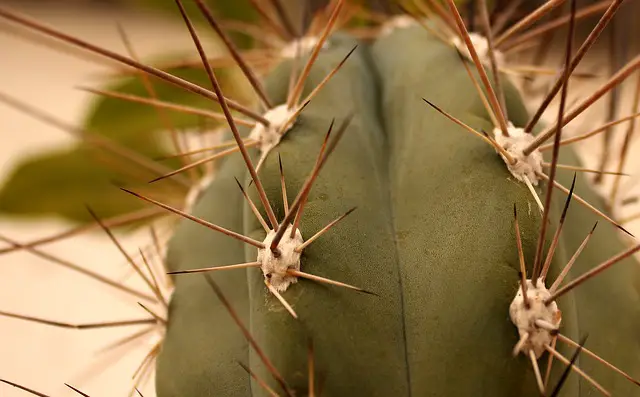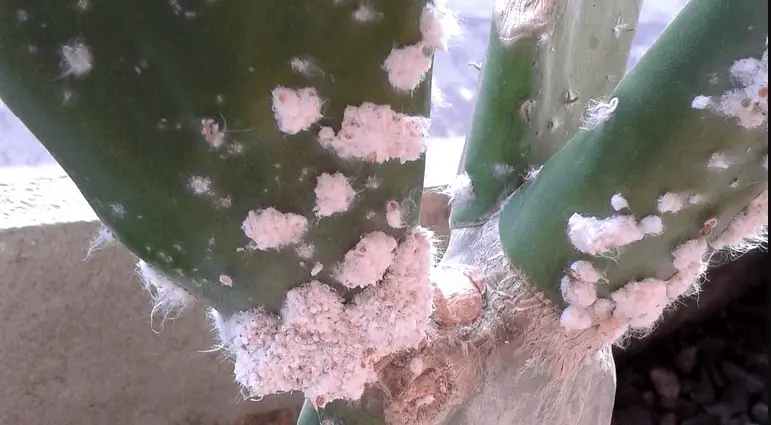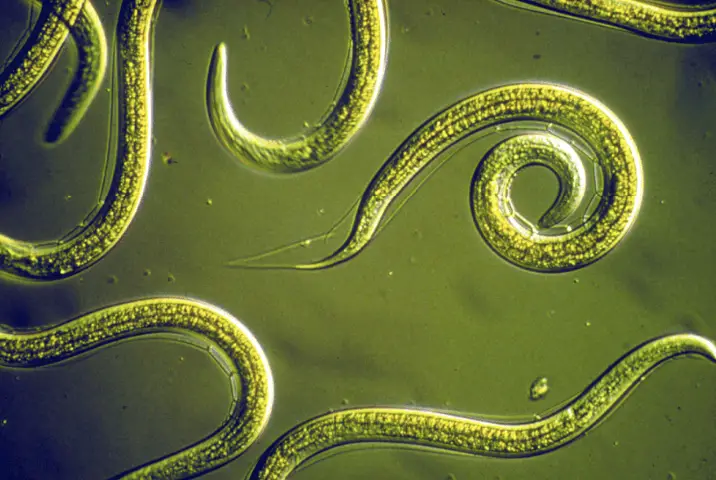Cactus needles will not fall out of the cactus plant easily, although cactus needles are sharp-edged, getting easily lodged into the skin or clothes.
A cactus plant can lose its needles easily because of the deficiency of nutrients, the need for fertilization, and pests like mealybug. Over-watering, burns, and poor sunlight are some infrequent reasons for the fall of cactus needles.

The needles of most cactus plants can also tell whether your plant is in good health. If your cactus is dropping its needles, it can lose its attractiveness and even die. Let’s know the various reasons of “will cactus needles fall out on their own and do cactus needles grow back?”
Reasons For The Cactus Needles To Fall Out On Its Own
Pests
Cactus needles can fall on their own due to pest infection. Mealybugs are the cactus pests that can be responsible for the fall of needles.
Mealybugs are tiny oval insects enveloped in white cottony material. Once mealybug infests a cactus plant, it spreads to different parts of the cactus. If you notice any white material on the plant, allow the cactus to dry out and remove it out of the pot to scrutinize its roots.

The white substance on the roots can be a mealybug invasion. Mealybugs suck the sap of the cactus plant and cause the fall of thorns. If untreated, it can kill your cactus.
Sometimes the cactus roots become the host for the Nematodes and when they are identified it is too late. Nematodes are very tiny and you will not be able to see them, so look for some other signs like puffy roots, discoloration of cactus, and fall of needles.

Needles can fall in the areas already affected by some other pests. These areas will be cured but new needles won’t develop in that area if substantial damage is done.
Deficiency of nutrients and fertilization
Deficiency of nutrients or fertilization in the soil can weaken your cactus resulting in loss of thorns or leaves. You need to repot your cactus plants every 3 years and fertilise them occasionally as the soil gets depleted of nutrients with time. Potassium deficiency can result in the fall of thorns of cacti. Therefore, fertilizers high in potassium and low in nitrogen are suggested for cactus plants.
It is recommended to fertilize cactus plants during the growing period. You can use liquid fertilizers by diluting them and using them during the summer. Slow-release fertilizers can keep the cactus plants nourished for months.
Deficiency of Sunlight
The deficiency of sunlight in desert areas or in areas with colder climates can be a reason behind the falling needles of your cactus.
Cactus plants love full sun, but they may need shade during the scorching heat in the afternoon and evening in summers. If the cactus does not get lots of sunlight for a longer time, it stops growing and will start losing thorns.
Overwatering or underwatering
Overwatering a cactus plant can result in shedding of thorns. A cactus plant placed in a sunny area needs more water, particularly during the growing season. Ensure that your cactus is dry before watering it again and use pots with drainage holes.
Sometimes, the cactus grown in cold areas is not allowed to go through dormancy in winters.
In winters, when the temperature is less with low sunlight, shift your cactus to a cool area of about 13°C to 15°C. Sparingly water your cactus plant once every 4 to 6 weeks if the soil is dry.
Placing your cactus near radiators and to stop or reducing the watering completely will lead to a thin cactus with elongated growth and roots loss.
When you keep your cactus indoors, there are more chances of overwatering as they don’t get enough sunlight, resulting in the loss of thorns.
In hot areas, larger cacti grown outdoors can remain underwatered and become shriveled. Bulky foliage and stems show ample water stored in a cactus.
Rotating your cactus frequently: Cactuses should not be rotated frequently, particularly near flowering. If you notice your cactus plant is kept indoors leaning, rotate to keep the part not getting enough sunlight towards it.
Avoid rotating your cactus if it’s ready to bloom as it can hamper the flowering process.
Rotting
Cactus needles can fall if the plant is rotting( dry or wet rot) caused by bacteria and fungi. If your cactus suffers from dry rot, it can grow brown and will cork starting from the base to the apex of the stem. If your cactus suffers from wet rot, the cactus can be pulpy and smooth.
Press your cactus gently, – if it is firm, it shows good health. Also, examine the roots, if you notice something abnormal, change the soil. Sterilize scissors or shears before you remove the infected roots or portion of the cactus. Wait for one week before you water your cactus plant and place it in the sunlight.
Physical Damage
Your cactus can lose spines because of the physical damage to your cactus. Your cactus can be damaged by your pets or other animals, careless handling, and some other reasons. This can lead to the falling of thorns easily from your cactus.
Glochids (furry spines) can easily fall and cactus plants of the genus Eriocacti ( earlier called Pariodia), are susceptible to losing their needles easily.
Sometimes, many cacti are on sale in the market with artificial flowers that are fixed using hot glue ( hot glue harms the stem) usually but are joined with pins as well.
The artificial flowers can be removed manually or will become detached in time. Remember that the thorns fallen from this region will not regrow again, although the damaged part will heal with time.
Do Cactus Needles Grow Back?
Cactus needles grow back in the same areoles, but in a separate place. On a healthy cactus plant, new needles grow on fresh areoles.
Cactus needles are transformed leaves that are present on cactus plants growing in hot, arid areas. These needles grow from a group of living cells known as primordia that become dead to form needles.
Cacti also have tubercles or podaria that are cone-like projections on areoles on which spines sprout can be found.
Spines vary in shapes and sizes, some can be thin or ridged and others are hefty, fluffy, twisted or flattened. The hue on the spines differs depending on the cactus variety. The glochid, a tiny, hairy barbed spine typically seen on Prickly pear cactus, is the most feared and lethal spine.
The areoles or spine cushions of a cactus may be lacking needles as they may have been harmed. Cactus plants’ needles are sometimes purposely removed.
Accidents can also be a reason that the plant’s spines could have been broken off. But, cactus needles can regrow within the same areoles, but may not sprout in the same position, regenerating in other locations.
Wait patiently as some cacti are slow growers, so new areoles may be formed in some time. Add a cactus or succulent fertiliser every week or every month to grow your cactus rapidly and provide it the morning sunshine. Avoid placing your cactus in the direct sunlight and slowly increase the duration of everyday light it receives. Sufficient sunlight boosts plant growth and may aid in the development of new spines.
